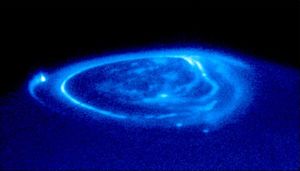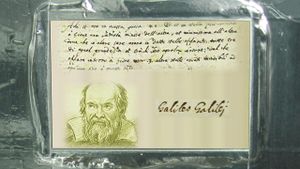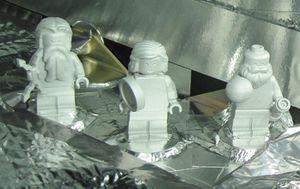جونو (سفينة فضاء)
 رسم تخيلي لجونو لدى وصوله لمشترى | |
| المشغل | ناسا |
|---|---|
| المتعهدون الرئيسيون | لوكهيد مارتن |
| نوع المهمة | مدارية |
| المرور على | الأرض |
| قمر | المشترى (مستقبلي) |
| تاريخ ولوج المدار | أغسطس 2016[1] |
| المدارات | 33 (مستقبلي) |
| تاريخ الاقلاع | 12:25:00، 5 أغسطس 2011 (EDT) (16:25:00 UTC) elapsed: 13 years, 7 months and 22 days |
| مركبة الإطلاق | Atlas V 551 (AV-029) |
| موقع الإطلاق | SLC-41، كيپ كاناڤرال، فلوريدا. |
| مدة المهمة | 6 سنوات أرضية (الرحلة: 5 سنوات، المهمة: سنة) |
| COSPAR ID | 2011-040A |
| صفحة الإنترنت | SWRI, NASA |
| الكتلة | 3,625 kilograms (7,992 lb)[1] |
| البطاريات | Two 55 amp-hour Lithium-Ion[2] |
| العناصر المدارية | |
| الرجيم | Polar |
| Periapsis | 4,300 kilometers (2,700 mi) |
| الأجهزة | |
| الأجهزة الرئيسية | Microwave radiometer, Jovian Infrared Auroral Mapper, Advanced Stellar Compass, Jovian Auroral Distribution Experiment, Jovian Energetic Particle Detector Instrument, Radio and Plasma Wave Sensor, Ultraviolet Imaging Spectrograph, JunoCam |
| دقة التصوير | (JunoCam) 15 km/pixel |
| Transponders | |
| Transponders | 4 (2 X-band, 2 Ka-band) |
جونو Juno، هي بعثة برنامج الجبهات الجديدة التابع لناسا إلى كوكب المشترى. أُطلقت السفينة الفضائية جونو من محطة كيپ كاناڤرال للقوات الجوية في 5 أغسطس 2011.[3] سترسو سفينة الفضاء في المدار القطبي لدراسة طبيعة الكوكب، حقل الجاذبية، المجال المغناطيسي، والغلاف المغناطيسي القطبي. كذلك، سيتم البحث عن أدلة تفسر كيفية تكون المشترى، ومنها ما إذا كان للكوكب بؤرة صخرية، كمية المياه الموجودة في الغلاف الجوي العميق، وكيفية توزيع كتلة الكوكب. كما سيتم دراسة الرياح القوية، والتي يمكن أن تصل سرعتها إلى 618 كم/س.[4]
اشتق اسم مركبة الفضاء من أسطورة يونانية رومانية. إلإله جوپيتر إختبأ في الغيوم ليحمي نفسه من الأذى، لكنه زوجته، الإلهة جونو، كان يمكنها النظر عبر السحب ورؤية الطبيعة الحقيقية لجوپيتر.[5]
ملخص المهمة
الفريق
خط زمني للإطلاق
أقلع الصاروخ الحامل للمرصد جونو يوم 5 أغسطس 2011 في تمام الساعة 16:25 توقيت عالمي منسق [6] على رأس صاروخ أطلس 5 من كيب كانافيرال . سيوضع المرصد في فلك ابتدائي حول الشمس خارج مدار الأرض . ثم تجرى تصحيحات على مسار المرصد سوف تتم في سبتمبر 2012 . وعن طريق ذلك فسوف يقترب المرصد في ميار نحو الأرض التي تقذفه مثل المقلاع بفعل الجاذبية في أكتوبر 2013 ويكتسب بذلك سرعة إضافية تكفي استمرار مساره في اتجاهه المشتري.
يبلغ زمن الرحلة بالكامل إلى المشتري 1و5 سنوات بحيث يصل المرص الفضائي جونو إلى المشتري في يوليو 2016 .[7] وعندما يصله سيتخذ الرصد مدارا قطبيه حول المشتري وتكون أقرب نقطة للمدار إلى المشتري على بعد 5000كيلومتر منه ، ويكون دورته حول المشتري في 11 ساعة . في ذلك المدار لن يدخل المرصد ويختفي في ظلام المشتري ، بذلك تستطيع خلاياه الشمسية إمداده بالتيار الكهربائي. سيحصل جونو عل أكبر طاقة خلال الستة ساعات التي يكون فيها قريبا من المشتري في كل دورة ، حيث تجرى القياسات الرئيسية خلالها . [8]
وتقدر الرحلة الأولية للمرصد الفضائي جونو نحو سنة ، يتم 32 دورة حول المشتري.
في 13 أغسطس 2013 أعلنت ناسا أن جونو قطع مسافة 897.733.760 ميل وهو في طريقه إلى كوكب المشتري، وبقيت مسافة مماثلة لكي يصل إلى أكبر كواكب المنظومة الشمسية. وقالت الوكالة أن المسبار جونو يعمل بصورة جيدة حسب البرنامج المقرر، وأن كافة الأجهزة العلمية في حالة سبات، وسوف تنشط فيما بعد. وبموجب حسابات الفريق العلمي، سيصل جونو إلى مداره يوم 5 يوليو 2016.[9] ومن وجهة النظر الفيزيائية، تعتبر جاذبية كوكب المشتري الأقوى بين كواكب المنظومة الشمسية، لذلك سوف يعمل المسبار جونو على مسافة بعيدة من الكوكب، ومع ذلك ستسمح الأجهزة المزود بها بدراسة الكوكب وتوابعه من الاقمار التي تدور حوله، وكذلك ما يسمى بالحزام الاشعاعي للمشتري. ومن المفترض أن يعمل المسبار حول المشتري مدة لا تقل عن 15 شهر. وسيكون جونو أول قمر صناعي يدور حول كوكب المشتري من الأعلى نحو الأسفل وليس من اليسار إلى اليمين أو بالعكس. ومثل هذا المدار سيسمح بشكل أفضل بدراسة بنية الكوكب وجوه.
الأهداف العلمية

The Juno spacecraft's suite of seven science instruments will determine:
- نسبة الأكسجين إلى الهيدروجين, effectively measuring the abundance of water in Jupiter, which will help distinguish among prevailing theories linking the gas giant's formation to the solar system.
- Obtain a better estimate of Jupiter's core mass, which will also help distinguish among prevailing theories linking the gas giant's formation to the solar system.
- Precisely map Jupiter's gravity to assess the distribution of mass in Jupiter's interior, including properties of the planet's structure and dynamics.
- رسم خريطة دقيقة للحقل المغناطيسي للمشتري لتقدير أصل وبنية الحقل ومدى العمق في المشتري الذي خـُلق فيه الحقل المغناطيسي. This experiment also will help scientists understand the fundamental physics of dynamo theory.
- Map the variation in atmospheric composition, temperature, structure, cloud opacity and dynamics to depths far greater than 100 bars at all latitudes.
- Characterize and explore the three dimensional structure of Jupiter's polar magnetosphere and its auroras.[10]
المدار
The probe's planned polar orbit is highly elongated and takes it close to the poles — within 4,300 kilometers (2,672 mi) — but then far beyond even Callisto's orbit.[11]
الأجهزة العلمية
| الجهاز | الاختصار | الوصف |
|---|---|---|
The primary goal of the radiometer is to probe the deep atmosphere of Jupiter at radio wavelengths ranging from 1.3 cm to 50 cm using six separate radiometers to measure the planet's thermal emissions.
| ||
| The primary goal of JIRAM is to probe the upper layers of Jupiter's atmosphere down to pressures of 5-7 bars at infrared wavelengths in the 2-5 μm interval using an imager and a spectrometer. | ||
The magnetic field investigation has three goals: mapping of the magnetic field, determining the dynamics of Jupiter's interior, and determination of the three-dimensional structure of the polar magnetosphere.
| ||
Will provide accurate pointing information of the Juno spacecraft for precise mapping.
| ||
JADE will resolve the plasma structure of the Jovian aurora by measuring the angular, energy and compositional distributions of particles in the polar magnetosphere of Jupiter.
| ||
JEDI will measure the energy and angular distribution of hydrogen, helium, oxygen, sulfur and other ions in the polar magnetosphere of Jupiter.
| ||
This instrument will identify the regions of auroral currents that define Jovian radio emissions and acceleration of the auroral particles by measuring the radio and plasma spectra in the auroral region.
| ||
UVS will record the wavelength, position and arrival time of detected ultraviolet photons during the time when the spectrograph slit views Jupiter during each turn of the spacecraft. Using a 1024 x 256 micro channel plate (MCP) detector, it will provide spectral images of the UV auroral emissions in the polar magnetosphere.
| ||
A visible light camera/telescope, included in the payload to facilitate education and public outreach. It will operate for only seven orbits around Jupiter because of the planet's damaging radiation and magnetic field.
|
الألواح الشمسية
الاتصالات
نظام الدفع
لوحة گاليليو وتمثايل لـِگو
- Plaque & LEGO figurines
التكلفة
انظر أيضاً
- أقمار المشترى
- الغلاف الجوي للمشترى
- المذنب شوماكر-لـِڤي 9
- استكشاف المشترى
- پيونير 10، پيونير 11، ڤويادجر 1,، ڤويادجر 2
- كاسيني-هويگنز، New Horizons, Ulysses
- گاليليو ، أول بعثة لمدار المشترى
- Europa Jupiter System Mission، مقترحة
- Jupiter Icy Moons Explorer (JUICE)، قد تُطلق في مارس 2022
المصادر
- ^ أ ب "Juno Mission to Jupiter" (PDF). NASA. 04/09. p. 2. Retrieved April 5, 2011.
{{cite web}}: Check date values in:|date=(help) - ^ "Juno Spacecraft Information – Power Distribution". Spaceflight 101. 2011. Retrieved August 6, 2011.
- ^ Dunn, Marcia (August 5, 2011). "NASA probe blasts off for Jupiter after launch-pad snags". MSN. Retrieved August 31, 2011.
- ^ Winds in Jupiter's Little Red Spot almost twice as fast as strongest hurricane
- ^ "NASA's Juno Spacecraft Launches to Jupiter". NASA. August 5, 2011. Retrieved August 5, 2011.
- ^ "Spaceflight Now - Atlas Launch Report - Mission Status Center" (in englisch). Spaceflight Now. خطأ: لا توجد وحدة بهذا الاسم "month translator".. Retrieved خطأ: لا توجد وحدة بهذا الاسم "month translator"..
{{cite web}}:|archive-date=requires|archive-url=(help); Check date values in:|access-date=,|date=, and|archive-date=(help)CS1 maint: unrecognized language (link) - ^ Juno probe on target for 2011 departure to Jupiter
- ^ Juno Flight System & Payload
- ^ "مسبار "جونو" الامريكي في طريقه الى كوكب المشتري". روسيا اليوم. 2013-08-13. Retrieved 2013-08-27.
- ^ "Juno Science Objectives". University of Wisconsin-Madison. Retrieved 2008-10-13.
- ^ Moomaw, Bruce (March 11, 2007). "Juno Gets A Little Bigger With One More Payload For Jovian Delivery". SpaceDaily. Retrieved August 31, 2011.
وصلات خارجية
- Official website on NASA.gov
- Juno mission web site on South West Research Institute
- Juno Mission Profile by NASA's Solar System Exploration
- NASA Selects New Frontiers Concept Study: Juno Mission to Jupiter at NASA Jet Propulsion Laboratory
- The Juno Mission to Jupiter at Space.com
- NASA 360 New Worlds New Discoveries 1/2. Retrieved June 30, 2011.
- Juno Instruments (includes link to make paper scale model here)







